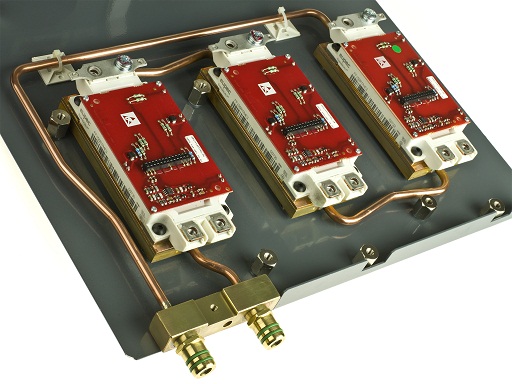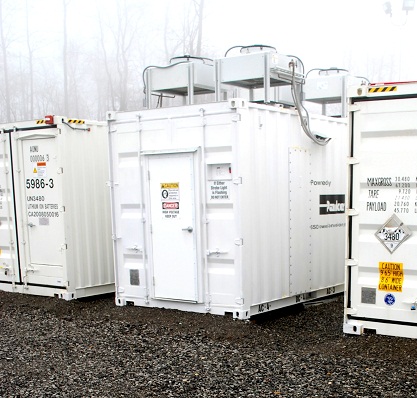
The long enclosures at the Laurel Mountain wind farm house batteries while inverters sit in shorter enclosures between them. The wind farm substation is to the right of the containers. From there, transformers step up he output to 13,000V for transmission. The power storage has been online since Oct 2011. One online estimate pegs the cost for the transformers and support equipment at $28.8 million. Photo: AES Energy Storage LLC.
Utilities continue working on better ways to stabilize the grid because the power they sell may come from several sources. One advantage to using a large battery is that it provides ramp-rate control, a way to smooth the addition or removal of power onto or from the grid. One such battery sits on a mountain top in West Virginia, next to the 98 MW, Laurel Mountain wind farm. The entire facility is a collaboration of AES Wind Generation, AES Energy Storage, battery manufacturer A123 Systems, and inverter supplier Parker Hannifin Corp., supplying power to regional transmission organization PJM.
At the time of its commissioning, the 32-MW unit was the largest Lithium-Ion battery array in the world. But the battery is only half of the equation. Its controls are the other half. In that effort, Parker Hannifin provided assistance with inverters that transform DC power to AC, and the reverse when charging the battery.
“The Parker part of the equation is the Power Conversion System or PCS, and it is a traffic cop between the grid and batteries,” says Louis Lambruschi, Parker’s marketing services and e-business manager. The PCS lets the batteries charge when there is an excess of grid power and discharge when the stored power is needed.
The active power components – insulated gate bipolar transistors or IGBTs – are mounted in replaceable drawers which can be slid out by one person without rigging. The drawers weigh about 40lb so one person can move an IGBT phase module and replace it in under 15 minutes. The company has patented the feature.
The West Virginia site is made of several combinations of an inverter container flanked by battery containers. So it would not be difficult to scale up this facility to store more power. There is a substantial substation on site and that is the grid interconnect.
Cooling the high-power components is another part of the system. “We collaborated with Parker’s Precision Cooling Division to design a two phase, liquid-cooling system for use in the PCS,” says Lambruschi. “Without the two-phase cooling, this facility would have been larger to accommodate more hardware. Air cooling alone is not as efficient because it needs air conditioning units and other devices.” The same cooling technology has been extended to the batteries and other heat-producing components.
Lambruschi says Parker previously worked with AES Energy Storage on a 12 MW installation in Chile in 2010. Prior to that, he says, Parker worked on a couple proof-of-concept systems in 2008 and 2009, small one and two-MW facilities. “Those outperformed their expectations and we continue to work with AES on upcoming projects. They have announced we will be involved in another system going into Chile in 2014.”
Lambruschi add that projects of this sort are constant learning processes because the technology is only five years old. “In 2007 when we first started getting into this, all installations were small because power utilities were breaking new ground. Since then, several of the proof-of-concept systems have been validated by multiple agencies, and we have learned ways to make the system more efficient. The cooling system has made a huge difference as the sizes of the projects have scaled up.”

The IGBTs sit on cooling plates that remove heat from the active components with a two phase cooling fluid. Its transition from liquid to vapor carries away more heat than air or water cooling would provide. A drawer of IGBTs weighs about 40 lb and can be swapped out by one person.
One of our earliest systems, for instance, was slated for installation in an unusually high altitude. In order to compensate for the thinner air at that altitude, we had to supply a higher power inverter than would have been necessary at sea level. With the two-phase cooling system, this de-rating is no longer necessary, and we can get the same power from less hardware. This translates to a more efficient package, and a lower cost.
Filed Under: Energy storage, Featured, News, Projects





